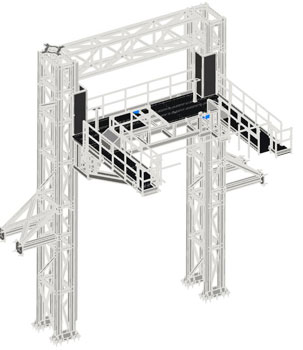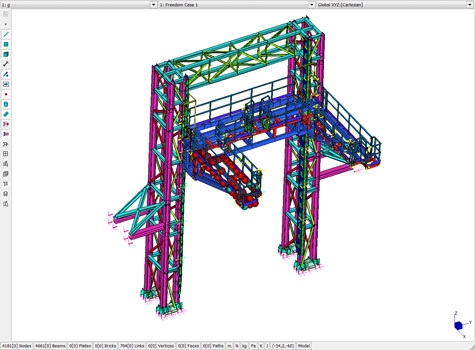The lift is a part of a large and complex production plant and it is used to transfer the operators atop a 10 m-height girder frame, to allow concrete casting operations in a batter and safer configuration.
Whilst generally satisfied by the equipment functionality, the customer was focused on few critical areas to be necessarily improved. In detail, the vertical translation of the lift was affected by harsh mechanical impacts and lack of smoothness. This was causing unexpected wear of several mechanical components, requiring continuous and expensive maintenance activities.
We have been requested to investigate the root cause of the detected structural deficiencies and to propose targeted solutions in order to upgrade the project without modifying the overall design.
Category: Elevation plants
Date: 2019
Max lift stroke: 9.460 m
Nominal lifting speed: 0.1 m/s
Load bearing capacity: 1000 kg


Objectives
Our objective was oriented to the structural analysis of the structural frame and to the final certification of the Lift. In the meantime, we were focused on a detailed investigation of the detected issues, in order to support the customer with the needed project upgrade, without significantly impacting on the existing design.
to be met
Taking into account the mandatory request of the customer to implement just few minor changes to the original design, our challenge was to identify the deficiencies roots and to implement the key needed improvements.
and results achieved
Starting from a global approach on the full configuration of the lift, we focused our efforts on the functional and structural characterization of the mechanical components by means of local calculation approaches. Every single item of the Lift has been deeply analyzed under the most severe operational conditions.
After combined numerical simulations, a lack of stiffness of the structural elements of the frame supporting the driving mechanical components has been detected. This has been pointed as the most critical issue. Basically, wear and structural damages of the mechanical components belonging to the driving system were caused by poor linkage with the housing frame. By means of strength and fatigue verifications, some targeted solutions have been proposed, analyzed and finally designed.
The technical book of the Lift with the relevant stress analysis report has been produced in order to get the full certification of the machine. Some specific upgrades have been implemented without changing the overall design. The analysis approach has been appreciated by the customer and it has allowed the designer to catch several design deficiencies and potential upgrades. The implemented numerical simulation models have proved to be reliable and they’re able to provide further structural investigations devoted to the full project optimization.


